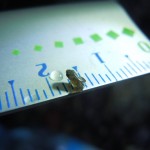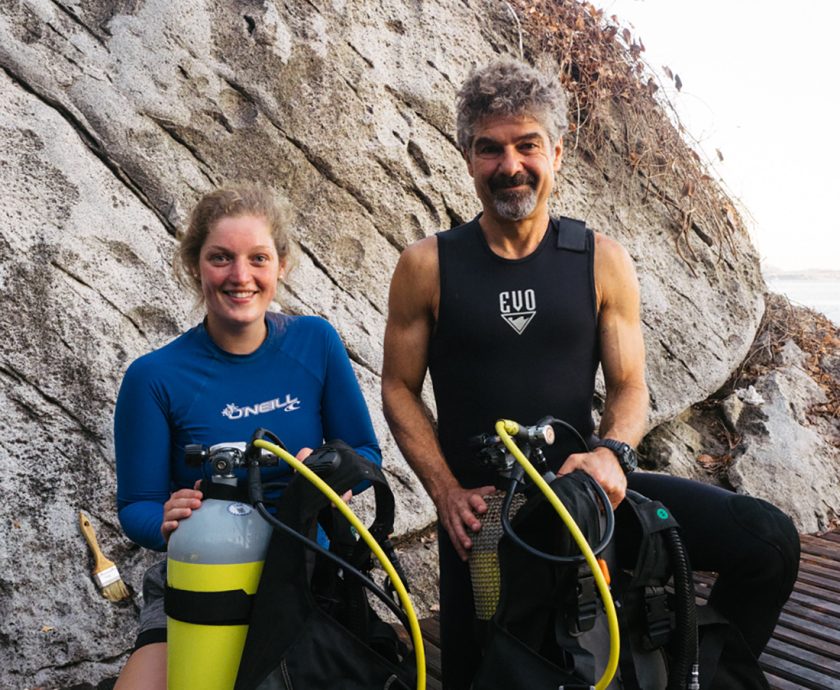The first thing that springs to mind when thinking of conservation and ecotourism in Madagascar is the lemur and the Black Lemur (Eulemur Macaco) is probably the favourite animal of many of our volunteers that have visited the island. Lemurs are found nowhere else in the world and Black Lemurs are to be found only in the north-western parts of Madagascar.
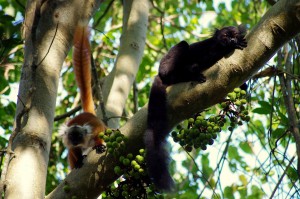 Male Black Lemurs (as the name suggests) are black or a dark chocolate colour with thick fur and long tufts of black hair around the ears. Females of the species have radically different appearances to males, having led to the belief for many years that they were a completely different species of lemur. Females are lighter brown to chestnut in colour with white bellies and white tufts around the ears. There are actually two species of Black Lemur – the Eulemur macaco which has brown or orange eyes is considered to be vulnerable and Eulemur flavifrons which is critically endangered and is the only primate (other than humans) to have blue eyes.
Male Black Lemurs (as the name suggests) are black or a dark chocolate colour with thick fur and long tufts of black hair around the ears. Females of the species have radically different appearances to males, having led to the belief for many years that they were a completely different species of lemur. Females are lighter brown to chestnut in colour with white bellies and white tufts around the ears. There are actually two species of Black Lemur – the Eulemur macaco which has brown or orange eyes is considered to be vulnerable and Eulemur flavifrons which is critically endangered and is the only primate (other than humans) to have blue eyes.
The Lemur’s primary food is fruit, making up 78% of its diet making them significant agents for seed dispersal. You’ll come across many photos of our volunteers sharing their fruit (especially bananas) with the lemurs around our research centre. They also eat flowers, leaves, fungi and some invertebrates, and during the dry season you will find them feeding on nectar.
Black Lemurs live in groups of 2 to 15 members with more or less equal numbers of males and females, where females are dominant. They are active during the day and night and forage in the upper and middle canopy of the forest at night but in the understory in the day. One of the biggest threats to the lemur is loss of habitat and in degraded areas you will even find them foraging on the ground.
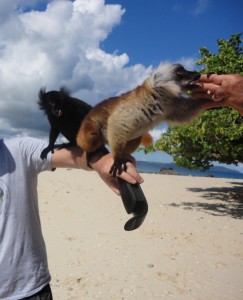 It’s also been noted that Black Lemurs regularly pick up and bite toxic millipedes to force them to release toxins in self-defence and them rub it on themselves to deposit the toxin on their fur. This usually isn’t fatal to the lemurs and we aren’t quite sure why they do it. Some believe the toxin repels other insects while other researchers suggest they do it to achieve a high. When they inhale or ingest enough of the toxin, it inhibits their monoamine oxidase system, resulting in the high. I don’t know about you, but that certainly brings King Julian from Disney’s “Madagascar” to my mind…
It’s also been noted that Black Lemurs regularly pick up and bite toxic millipedes to force them to release toxins in self-defence and them rub it on themselves to deposit the toxin on their fur. This usually isn’t fatal to the lemurs and we aren’t quite sure why they do it. Some believe the toxin repels other insects while other researchers suggest they do it to achieve a high. When they inhale or ingest enough of the toxin, it inhibits their monoamine oxidase system, resulting in the high. I don’t know about you, but that certainly brings King Julian from Disney’s “Madagascar” to my mind…
Did you Know
The word “Lemur” is actually Latin for “ghost”. They were probably named thus because living so high up in the forest canopy, they were rarely seen but their calls were easily heard from the ground. These calls include a recognition grunt (that sounds more like a duck’s quack) when identifying each other, a cohesion call to keep track of each other, an alarm call to warn of predators and the purr of contentment that babies use when being groomed.
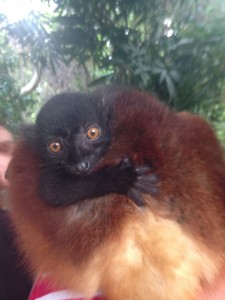 Conservation
Conservation
The main threat to Madagascar’s lemurs is deforestation for agriculture, firewood and charcoal production, logging and burning to create pastures for cattle. Sadly, they are also hunted for food and captured for the pet trade or for zoos. Black Lemurs also raid crops, which is another reason they are killed.
Madagascar’s unique isolated island evolution makes the island the world’s highest priority for conservation, with new species being discovered all the time. Even as late as the 1980s, two new species of lemurs were discovered. Volunteer programs like our forest conservation program, are vital in the preservation of its wildlife.
So how will ecotourism in Madagascar benefit the Black Lemur?
Given it’s tolerance of people and adaptability to having its habitat disturbed, it has a higher chance of survival in close proximity to humans than it less adaptable cousins, making ecotourism a promising way to preserve safeguard their future.
The worldwide growth in ecotourism is a strong economic incentive for Madagascar to preserve its natural environment. The unique animal life and hot springs offer potential tourist attractions and future jobs. Efforts are now being made to replant 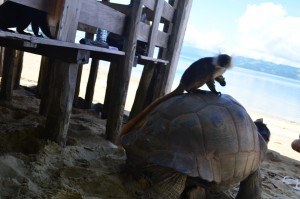 steep, barren slopes affected by landslides that are unsuitable for agriculture with fruit trees and to restore channels to revive abandoned rice fields. This will restore the natural habitat of the lemurs whilst also improving the lives of the local farmers – a win-win situation for all.
steep, barren slopes affected by landslides that are unsuitable for agriculture with fruit trees and to restore channels to revive abandoned rice fields. This will restore the natural habitat of the lemurs whilst also improving the lives of the local farmers – a win-win situation for all.



